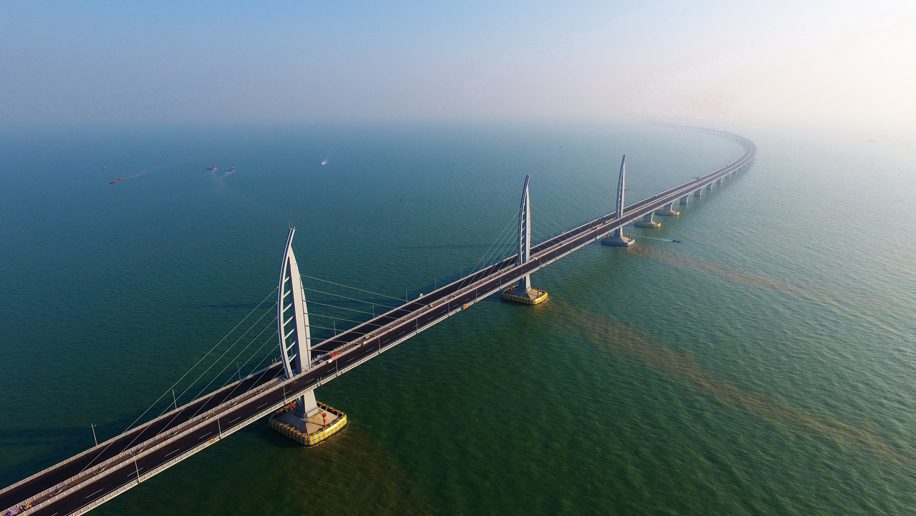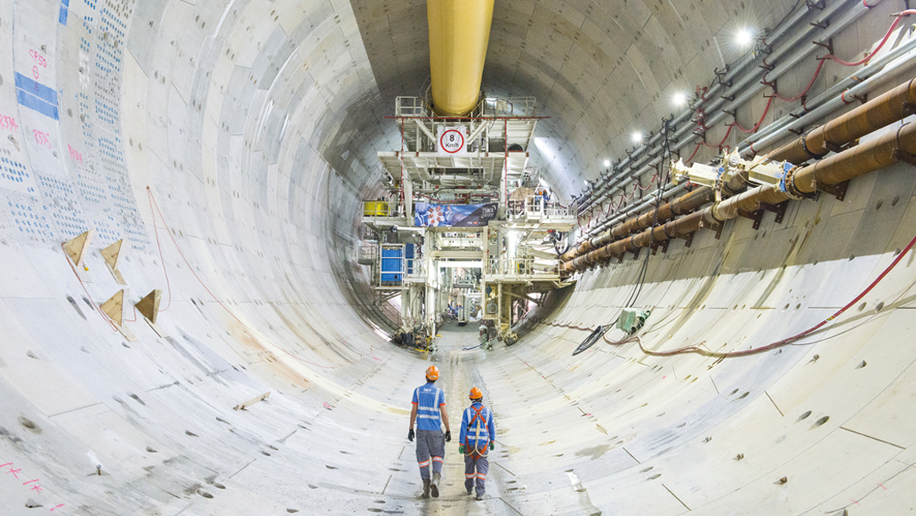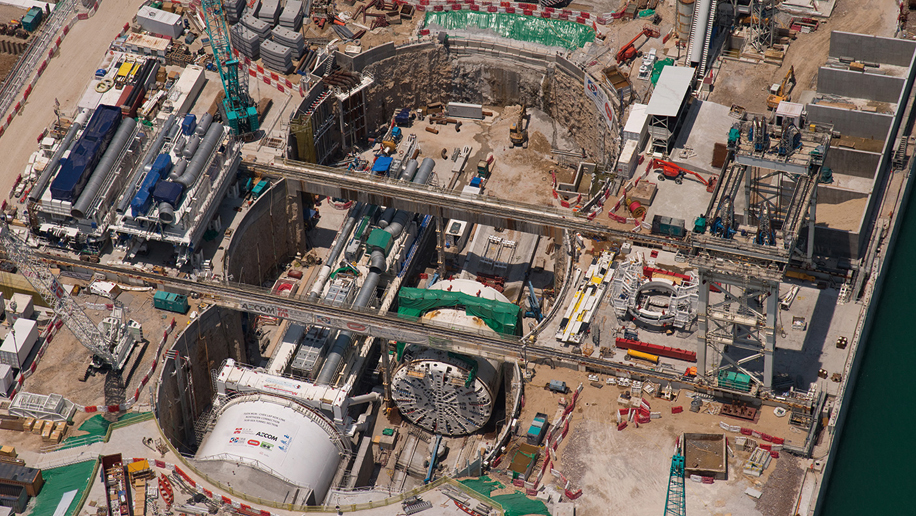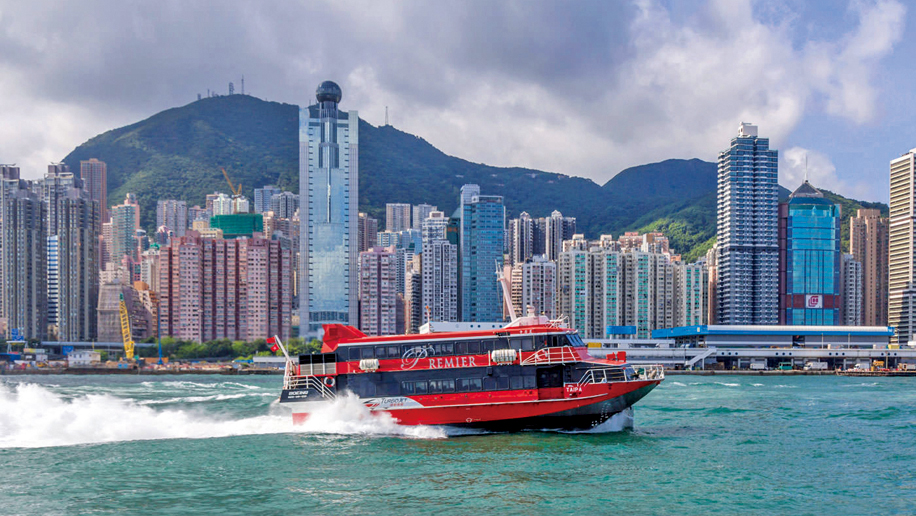
Four man-made islands, a 22.9-kilometre-long stainless-steel bridge weighing some 400,000 tonnes, and the longest submerged sea tunnel in the world… this is the new Hong Kong-Zhuhai-Macau Bridge (HZMB), soon to be the world’s longest cross-sea bridge and the jewel in the crown of a new wave of developments aimed at fostering greater integration between the cities of the Pearl River Delta (PRD).
The HZMB project – which totals 55 kilometres in length – began construction in December 2012 as part of a joint effort by Hong Kong, Macau and the Chinese mainland, though the idea for a connection across the Lingding Channel that separates the cities was originally floated back in 1983. Fast-forward 35 years and the bridge is nearly complete, with the opening slated before the end of June.
The benefits of the HZMB will be twofold: a reduction in transportation times, and economic integration. In 2015, the PRD region accounted for 4.3 per cent of China’s total population and 9.1 per cent of its GDP, according to the Hong Kong Trade and Development Council. With the Western PRD reachable in three hours from Hong Kong, its attractiveness for external investment will be given a handsome boost.
The HZMB Authority projects that daily passenger flow across the bridge will be about 56,000 people when it first opens, increasing to 230,000 by 2035. Between 90 and 140 buses, operated by a subsidiary of Hong Kong-based Shun Tak Holdings that currently runs the Hong Kong-Macau TurboJet ferry service, will run daily between all three border checkpoints (every five minutes during peak hours). Fares are expected to be HK$80 (US$10) to get to Zhuhai – significantly lower than the current HK$220 (US$28) ferry and HK$130 (US$17) coach costs using different routes.

The HZMB has been a major undertaking. Starting from Hong Kong, the bridge begins at the Hong Kong Border Crossing Facilities on an artificial island to the west of Lantau Island adjacent to Hong Kong International Airport (HKIA). From here the 12-kilometre-long Hong Kong Link Road runs west out into the Lingding Channel to the edge of the Hong Kong border.
The bridge then connects with a second artificial island that leads into the sea tunnel – a necessity to avoid obstructing the nearly 4,000 ships that use the channel daily – which extends 6.7 kilometres under the channel at a depth of 40 metres before emerging once again at a third artificial island. This then leads on to the main 22.9-kilometre stretch of the bridge, comprising a total of 2,156 connected box girders that cross the rest of the channel to the Zhuhai-Macau Boundary Crossing Facilities on the northeastern edge of Macau. A further Zhuhai Link Road extends beyond this into the Chinese mainland.
It’s worth noting that drivers in Macau, Hong Kong and mainland China don’t share the same traffic rules – Macau and Hong Kong drive on the left side of the road, UK style, but the mainland follows the US by driving on the right. Earlier this year the HZMB Authority declared that the entire bridge will follow mainland China’s traffic rules, meaning all vehicles will have to keep to the right while on the bridge. Additionally, all tolls will have to be paid in renminbi, regardless of origin or destination – though you’ll be able to pay using non-cash options such as bankcards, electronic wallets such as Alipay and WeChat Pay, and Autopay, which already exists for bridge and tunnel toll collection in Hong Kong.
It certainly hasn’t all been smooth sailing for the bridge’s development. Originally slated to open in 2016, the project has been plagued by delays and despite its expected opening this year, at time of writing it still doesn’t have a definitive launch date. Beset by workplace accidents as well as investigations into corruption surrounding contractors faking concrete test results, which led to further construction problems, the overall cost of the bridge has exceeded the initial budget by at least HK$11.8 billion (US$1.5 billion) – around 30 per cent more than the original HK$38 billion (US$4.8 billion) projected cost.

However, provided the bridge does indeed open this year, the gains will be seen across the three terminus cities immediately. For example, many of Macau’s food imports and other supplies come via Hong Kong – currently a journey of up to a day. Once the bridge is open though, this will be reduced to about 30 minutes.
Of course trade will be bolstered by greater interconnectivity across the Lingding Channel, but travellers and corporate event delegates also stand to benefit. Speaking with our sister publication Mix Meetings last year, Stephane de Montgros, co-founder and director of Riviera Events, noted that the bridge would open up facilities across all three cities to tourists and event organisers.
“Leveraging the resources that the three areas have in terms of quality accommodation, creative food and beverage, entertaining activities and world-class event spaces, will contribute to establishing South China as the leading destination for MICE [meetings, incentives, conferences and exhibitions] events in Asia,” he said.
“We have no doubt the governments of the different areas will continue to upgrade the border crossing experience, which will be key in offering a pleasant and smooth experience when travelling between the three areas. The rollout of the e-gate system for both locals and foreigners [in 2016] has been a fantastic improvement.”
Other facilities designed to capitalise on the increased cross-flow of travellers include the Tuen Mun-Chek Lap Kok Link (TM-CLKL), a dual carriageway connecting the Hong Kong Boundary Crossing Facilities at Hong Kong airport to the city’s Tuen Mun district on the western edge of the Kowloon Peninsula, which will improve access to the airport for travellers coming from the Shenzhen border.
Then there’s the new SkyCity mixed-use complex at HKIA, set to open in 2020 between Terminal 2 and AsiaWorld-Expo, that will include retail, dining, entertainment and commercial space, plus a second 1,000-room airport property from Regal Hotels Group.

As well as providing an economic boost to Hong Kong, Zhuhai and Macau, China’s government has broader plans to develop a Greater Bay Area that will comprise cities across Guangdong province including Guangzhou, Shenzhen, Foshan, Zhongshan, Dongguan, Huizhou, Zhaoqing and Jiangmen… the latter’s local government, in preparation, plans to invest some RMB100 billion (US$15.9 billion) for new industrial and property development to help integrate with its more developed neighbour cities.
Some sectors though do not stand to gain from the opening of the bridge, most notably the ferry companies, who are adapting to the likely hit to their business. Some operators like Zhuhai High Speed Passenger Ferry Co are adjusting their strategies, planning to upgrade and focus more on marine tourism. Others, such as Cotai WaterJet, are partnering with airlines to offer their own form of enhanced connectivity across the channel. In February this year Cotai WaterJet entered into a codeshare agreement with Cathay Pacific (CX) that enables travellers to book a single itinerary through to Macau’s Taipa Ferry Terminal on one of six daily ferries via the SkyPier at HKIA. As with air route codeshares, this means you can check your luggage all the way through to the final destination in Macau. Initially open to those travelling from Australia, Canada, New Zealand, Singapore and the US, the service is set to roll out across additional international markets in future.
The SkyPier itself connects to nine ports scattered throughout the Pearl River Delta (including Macau), with approximately 90 ferry trips operating each day between these ports and the airport. “SkyPier also provides upstream check-in services for sea-to-air passengers from Macau,” said a spokesperson for the Airport Authority of Hong Kong. This feature is particularly geared towards incentive groups travelling to and from Macau via Hong Kong, especially when it comes to improved check-in procedures for travellers departing Macau.
Back in Hong Kong, the Airport Authority also has initiatives that enable event organisers to set up dedicated meet-and-greet counters for delegates in the terminal area, along with setting up dedicated containers for handling baggage for large groups, thus speeding up the baggage-handling process.

“If a conference is held in Macau and the group is using SkyPier ferries, the Airport Authority can make special arrangements with ferry operators, including chartering ferries tailored to the flight arrival time, shortening times at Hong Kong airport,”
the spokesperson added.
These enhancements all make sense and add value, but it’s the HZMB that still forms the backbone of HKIA’s plan to become the major hub connecting the PRD with the rest of the world. With this in mind, it is developing an Intermodal Transfer Terminal (ITT) at the airport that will connect to the Hong Kong Boundary Crossing Facilities via a bonded bridge.
The proposed location of the ITT is currently to the south of the SkyPier and will operate in a similar fashion, primarily serving tourists to and from Macau and Zhuhai who fly in and out of HKIA. Passengers coming from the western PRD via the HZMB will be able to enter the airport in one or two minutes from the Hong Kong Boundary Crossing Facilities without needing to go through extra border checks.
With travel time from Zhuhai to HKIA set to improve dramatically – from four hours to just 45 minutes – there’s every chance the HZMB will indeed bring about the Pearl River Delta integration that its proponents have long been touting. When it finally does open, that is…

Fact file
Total length of HZMB
55 kilometres
Length of primary cross-sea bridge
22.9 kilometres
Length of undersea tunnel
6.7 kilometres
Length of Hong Kong Link Road
12 kilometres
Length of Zhuhai Link Road
13.4 kilometres
Macau-HKIA travel time
30 minutes
Zhuhai-HKIA travel time
45 minutes
Lifespan of HZMB
120 years
Bus services
Between 90 and 140 buses daily
Bus fare
Hong Kong-Zhuhai: HK$80 (US$10)
Bus frequency
Peak hours – every five minutes
Non-peak hours – every 10-15 minutes
Night service – every 15-30 minutes
Toll
Cars RMB200 (US$32)
Trucks RMB200-300 (US$32-48)












